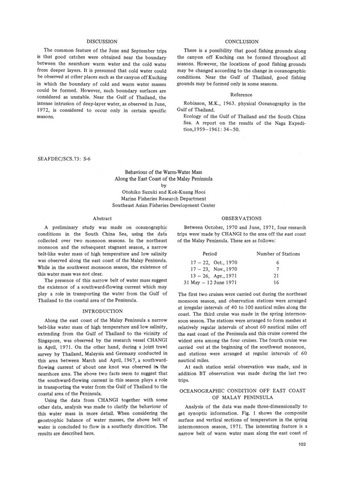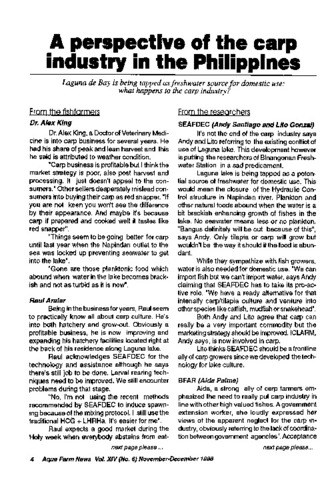Behaviour of the warm-water mass along the east coast of the Malay Peninsula
Share
Abstract
A preliminary study was made on oceanographic conditions in the South China Sea, using the data collected over two monsoon seasons. In the northeast monsoon and the subsequent stagnant season, a narrow belt-like water mass of high temperature and low salinity was observed along the east coast of the Malay Peninsula. While in the southwest monsoon season, the existence of this water mass was not clear.
The presence of this narrow belt of water mass suggest the existence of a southward-flowing current which may play a role in transporting the water from the Gulf of Thailand to the coastal area of the Peninsula.
Suggested Citation
Suzuki, O., & Hooi, K.-K. (1977). Behaviour of the warm-water mass along the east coast of the Malay Peninsula. In Proceedings of the Technical Seminar on South China Sea Fisheries Resources, Bangkok, Thailand, 21-25 May 1973 (pp. 103-106). Tokyo, Japan: Japan International Cooperation Agency.
Subject
Related items
Showing items related by title, author, creator and subject.
-
Water management (supply and quality)
Ingthamjitr, Suchart (Secretariat, Southeast Asian Fisheries Development Center, 2008)Water (H2O, HOH) is the most abundant molecule on Earth's surface, composing 70- 75% of the Earth's surface as liquid and solid state in addition to being found in the atmosphere as a vapor. It is in dynamic equilibrium ... -
A perspective of the carp industry in the Philippines
Southeast Asian Fisheries Development Center, Aquaculture Department (Aquaculture Department, Southeast Asian Fisheries Development Center, 1996)Fish farmers in Laguna de Bay are facing conflict of the use of the lake which is being tapped as freshwater source for domestic use. The article documents the perspectives of some fish farmers and researchers on the ... -
Choosing good site for cage culture
Aldon, Eva (Aquaculture Department, Southeast Asian Fisheries Development Center, 1998)





